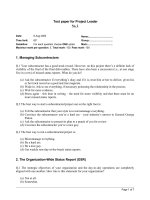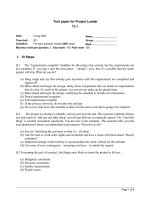Test paper for Project Leader No 2
Bạn đang xem bản rút gọn của tài liệu. Xem và tải ngay bản đầy đủ của tài liệu tại đây (123.78 KB, 7 trang )
Test paper for Project Leader
No. 2
Date: 6 Aug 2005
Name:....................................
Time limit: 60’ Group:...................................
Guideline: For each question choose ONE option Mark:......................................
Maximun mark per question: 5, Total mark: 150, Pass mark: 100
1. Managing Subcontractors
Q.1 Your subcontractor has a good track record. However, on this project there’s a definite lack of
visibility of the final of the final deliverables. There have also been a succession (i.e., at one stage five
in a row) of missed status reports. What do you do?
(a) Ask the subcontractor if everything’s okay and if it is, trust him or her to deliver, given his or
her track record as a good and true magician.
(b) Wade in. Ask to see everything, if necessary poisoning the relationship in the process.
(c) Wait for more evidence.
(d) Stress again – this time in writing – the need for more visibility and that there must be no
more missed status reports.
Q.2 The best way to start a subcontracted project out on the right foot is:
(a) Tell the subcontractor that your style is to micromanage everything.
(b) Convince the subcontractor you’re a hard ass – your industry’s answer to General George
Patton.
(c) Ask the subcontractor to present its plan to a punch of you for review.
(d) Convince the subcontractor you’re a nice guy.
Q.3 The best way to run a subcontracted project is:
(a) Micromanage everything.
(b) Be a hard ass.
(c) Be a nice guy.
(d) Get weekly non-day-at-the-beach status reports.
2. The Organization-Wide Status Report (OSR)
Q.1 The strategic objectives of your organization and the day-to-day operations are completely
aligned with one another. How true is this statement for your organization?
(a) Not at all.
(b) Somewhat.
Page 1 of 7
(c) Nearly
(d) Completely.
Q.2 Your goals for this year are so clear that everybody will know when they have been achieved.
How true is this statement?
(a) Not at all.
(b) Somewhat.
(c) Nearly.
(d) Completely.
Q.3 In your organization, every one knows the big picture and his or her part in it. How true is this
one?
(a) Not at all.
(b) Somewhat.
(c) Nearly.
(d) Completely.
3. Project Management Performance Model
Q.1 A written plan exists for your organization. It shows the tasks that have to be done. The effort
involved in carrying out the tasks and achieving the goal has been quantified in some way. How true
is this statement for your organization?
(a) Not at all.
(b) Somewhat.
(c) Nearly.
(d) Completely.
Q.2 How do you know that the people who report to you can be relied on to make their piece of the
plan that happen?
(a) Because they can show you a plausible plan.
(b) Because you trust them.
(c) Because they have a track record.
(d) Because they said they would.
Q.3 Take any if the people who report to you. How much would you bet that this person will make his
or her piece if the plan happens?
(a) Pass – I can think of plenty of other ways to blow my money.
(b) $5.
(c) $20.
(d) $100 or more.
Page 2 of 7
4. Figuring Out Where You Are
Q.1 Your organization consists of you as leader, five direct reports, and a team of 30 people. How
much time is this going to need from you in term of management?
(a) All your time (i.e., it’s a full-time job).
(b) Half of your time.
(c) It’s the work of three people.
(d) Dunno, but I seem to work harder every year.
Q.2 You run your own company. You started it several years ago; it’s grown rapidly, and now
conscious of your own limitations, you feel the times has come to “strengthen your management
team.” What do you do?
(a) Enroll them all in the local gym.
(b) Hire a hotshot CEO.
(c) Figure out a management structure, use the rule of thumb from the answer to question 1 to
calculate how much effort is needed where, write profiles for the various positions, and fill
them form new or existing staff, focusing on trying to get the closest match to the profile.
(d) Enroll all of your current managers in MBA programs or other training.
Q.3 You’ve just joined a new company, and the organization you’re going to run definitely needs a
new management structure. How do you do it - that is, how do you “figure out a management
structure”?
(a) Buy the latest and greatest management bestseller - it’ll tell you.
(b) Use a hierarchical structure, but a somewhat flat one – that is, not with to many layers
(c) Use a matrix structure with dotted line reporting, where necessary.
(d) Make sure every piece of your organization has somebody responsible for it.
5. Start Making It Better
Q.1 Your organization is well established, as are its competitors. An unspoken sort of “truce” exists
between you and your competitors - this year maybe you steal a percentage point or two of market
share; next year it swings back toward one of them. Live and let live. Everybody’s making a living,
and while things may not always run to target, “the importance things always get done.” What should
you do?
(a) Do nothing - if it ain’t broke, don’t fix it.
(b) Be very afraid - things won’t always be like this.
(c) Quantify how many things “may not always run to target” and whether “important things” do
always get done.
(d) Calculate how many years to your earliest retirement date, and if it’s a number less than five,
do nothing.
Page 3 of 7
Q.2 Your organization is young, growing fast, in a high-technology area, and - to some extent –
blazing a trail. Like any group of managers, those that report to you are of mixed ability, but this is
compounded by the nature of your business. What’s the best support you can give to your managers?
(a) Mentoring.
(b) Micromanagement.
(c) Stock options, bonuses, large salaries, big cars, or other performance-based financial
incentives.
(d) Get rid of the poorer ones and try to hire in hotshot.
Q.3 Same scenario as the previous one. It’s clear to you that the Internet and Web are going to be a
key part of your company’s strategy going forward. What’s your next move?
(a) Identify your requirements – what you would be trying to achieve by using this technology.
(b) Bring in presentations from a number of companies who specialize in Web work.
(c) Bone up on the technology yourself.
(d) Go looking for Web design people or companies.
6. Case Studies
Q.1 Your organization is young, growing fast in a high technology area. An opportunity comes along
that could have huge benefits – financially and in terms of growth – for you. The downside is that it
will put a huge stress on your finances and your people’s ability to cope. You will be so close to the
wire, for at least a year, that quite small slip-ups could sink you. What do you do?
(a) Do it anyway – it’s what got you where you are.
(b) Pass – it’s just too hairy.
(c) Get additional funding to cushion you – giving away equity, if necessary.
(d) Really go for broke. DO this and a few other things besides.
Q.2 What is the most common reason that project management improvement initiatives fails in
organizations?
(a) Lack of management commitment.
(b) Lack of funding.
(c) Reluctance to change on the part of the staff.
(d) Reluctance to invest in project management tools.
Q.3 If you build a culture of project management in your organization, among its negative effects will
be:
(a) The disappearance of “stretch goal” – objectives that really test your people’s metal.
(b) Boredom brought on by an almost complete absence of fire-fighting.
(c) Endless time spent creating and updating Gantt charts.
(d) Mind-numbing predictability.
Page 4 of 7
7. The Lazy Manager’s Weekly Routine
Q.1 Your natural management style is one of micromanagement, where you want to know the detail
on everything. You have a superstar manager reporting to you . By this I mean he or she is totally
reliable - just give him or her the job and you consider it done. What management style should you
use in these circumstances?
(a) Your natural one. A loepard can’t change its spots.
(b) As in (a) but do so with the intention of learning how he or she does it, so you can see if you
can pass that learning onto others.
(c) Leave him or her to it.
(d) Go with micromanagement – just to be sure.
Q.2 Your natural management style is to let somebody get on with the job. Your favorite saying is “
What’s the point in having a dog and barking yourself?” (In these politically correct times, you don’t
actually say this around the office!) You hire a new manager to work for you. At the interview, you
ask this manager straight out if he or she is the kind of person who, when you give him or her a job to
do, you can consider it done. Without hesitation, he or she answers “yes.” What management style is
right here?
(a) Micromanagement – you’ve never worked with this person before.
(b) Your natural style – it’s the perfect match.
(c) Something part-way between (a) and (b).
(d) Micromanagement to begin with and then back off when you see he or she doing okay.
Q.3 You have some body working for you who has ended up with a job that he or she is really not
capable of doing. You have a lot of personal loyalty to him or her, and the organization could “carry”
this person without too much financial or other disruption. The person would lose a lot of face if you
were to remove him or her. What do you do?
(a) Move this person to a job he or she can do.
(b) Just leave things as they are. If it ain’t broke, don’t fix it.
(c) Try and get the person to see the situation for himself or herself and have him or her offer to
make the move to another job.
(d) It’s an HR problem. Give it to the folks in HR.
8. Program for a Project - Based Organization
Q.1 You’ve just joined a new organization. After a few weeks observing, you decide that significant
parts of its senior management are dysfunctional, incompetent, are really not up to what is being
asked of them. What do you do?
(a) Wade in with in ax.
(b) Try to understand the problems and launch a program of staff and team development
(c) Begin micromanaging and mentoring the wayward ones.
(e) It’s an HR problem- give it to them, and if they won’t take it, quit.
Page 5 of 7









